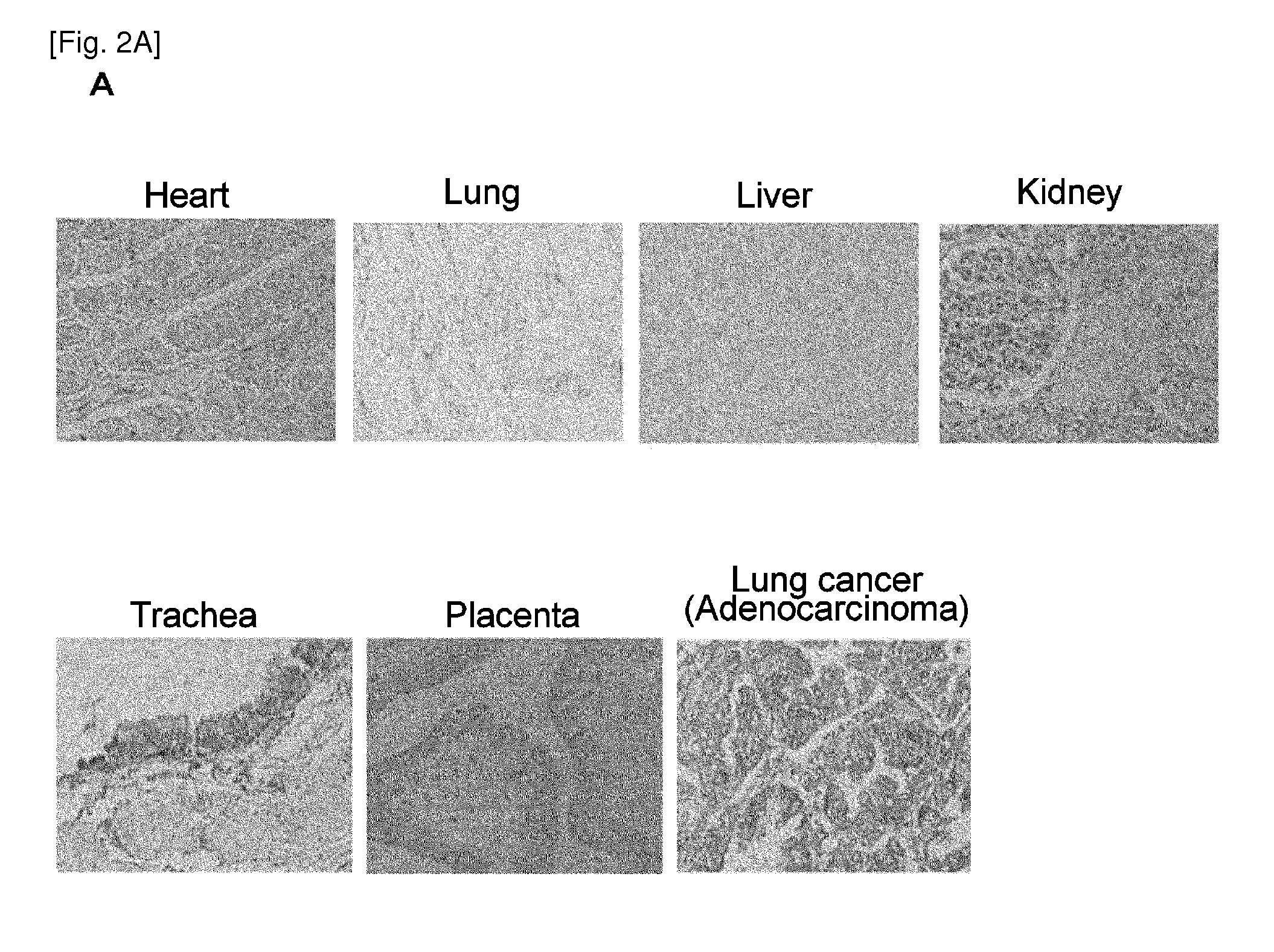Nectin-4 for target genes of cancer therapy and diagnosis
a cancer therapy and target gene technology, applied in the field of biological science, can solve the problems of limited proportion of patients showing good response and limiting the treatment regimen to selected patients
- Summary
- Abstract
- Description
- Claims
- Application Information
AI Technical Summary
Benefits of technology
Problems solved by technology
Method used
Image
Examples
example 1
General Methods
[0551]Cell lines and clinical tissue samples.
[0552]Twenty human lung-cancer cell lines used in this study are as follows: A549, LC319, H1781, PC-3, PC-9, PC14, A427, NCI-H1666, NCI-H358, RERF-LC-AI, SK-MES-1, EBC-1, LU61, NCI-H520, NCI-H1703, NCI-H2170, NCI-H226, NCI-H647, LX1, and SBC-5. Human bronchial epithelial cells, BEAS-2B was included in the panel of the cells used in this study. All cells were grown in monolayers in appropriate media supplemented with 10% fetal calf serum (FCS) and were maintained at 37 degrees C. in an atmosphere of humidified air with 5% CO2. Primary lung cancer samples as well as their corresponding normal tissues adjacent to resection margins from patients, who had no anticancer treatment before tumor resection, had been obtained earlier with informed consent (Kikuchi T, et al. Oncogene 2003; 22:2192-205). The histological classification of the tumor specimens was based on WHO criteria (Travis W D, et al. World Health Organization Interna...
example 2
Nectin-4 Expression in Lung Tumors and Normal Tissues
[0583]To search for novel target molecules for the development of therapeutic agents and / or diagnostic biomarkers for NSCLC, genes were first screened, which showed more than a 5-fold higher level of expression in cancer cells than in normal cells, in the majority of NSCLCs analyzed by cDNA microarray. Among 27,648 genes and ESTs screened, Nectin-4 transcript was identified as a good candidate that showed more than a 5-fold higher level of expression in 87.5% of NSCLCs. Its transactivation was confirmed by semi-quantitative RT-PCR experiments in 9 of 10 additional NSCLC tissues and in 7 of 20 lung-cancer cell lines (FIG. 1A). Further, in another semi-quantitative RT-PCR experiments, its transactivation was confirmed in 11 of 14 additional NSCLC cases (6 of 7 adenocarcinomas (ADCs); 5 of 7 squamous cell carcinomas (SCCs)), and in 7 of 20 lung-cancer cell lines (FIG. 1E). Original mouse monoclonal antibody specific to human Nectin-4...
example 3
Association of Nectin-4 Expression with Poor Clinical Outcomes for NSCLC Patients
[0584]To further verify the biological and clinicopathological significance of Nectin-4, the expression of Nectin-4 protein was examined by means of tissue microarrays consisting of NSCLC tissues from 422 patients who underwent surgical resection. A pattern of Nectin-4 expression was classified on the tissue array ranging from absent / weak (scored as 0˜1+) to strong (2+) (FIG. 2B, top panels). Of the 422 NSCLC cases examined, Nectin-4 was strongly stained in 245 (58.1%; score 2+), weakly stained in 119 (28.2%; score 1+), and not stained in 58 cases (13.7%; score 0), whereas their adjacent normal lung tissues were not stained (FIG. 2B, middle panels). Then, the association between Nectin-4 status and clinicopathological parameters was evaluated. As shown in Table 2, histological type (higher in ADC; P=0.0059 by Fisher's exact test) and pT factor (higher in T2-T4; P=0.0048 by Fisher's exact test) were sign...
PUM
| Property | Measurement | Unit |
|---|---|---|
| Fraction | aaaaa | aaaaa |
| Fraction | aaaaa | aaaaa |
| Fraction | aaaaa | aaaaa |
Abstract
Description
Claims
Application Information
 Login to View More
Login to View More - R&D
- Intellectual Property
- Life Sciences
- Materials
- Tech Scout
- Unparalleled Data Quality
- Higher Quality Content
- 60% Fewer Hallucinations
Browse by: Latest US Patents, China's latest patents, Technical Efficacy Thesaurus, Application Domain, Technology Topic, Popular Technical Reports.
© 2025 PatSnap. All rights reserved.Legal|Privacy policy|Modern Slavery Act Transparency Statement|Sitemap|About US| Contact US: help@patsnap.com



